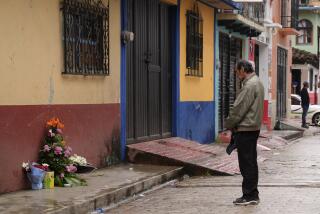Salvadoran Human Rights Commission Leader Slain
SAN SALVADOR â Two gunmen firing silenced automatic weapons killed the president of the Salvadoran Human Rights Commission today as he dropped his children off at school.
Herbert Anaya, 33, was the last surviving original member of the Human Rights Commission, founded in 1979 to monitor human rights in the country. He was the second commission president to be killed.
âIt is the work of death squads tied to the security forces, and we hold the government and their security forces directly responsible,â the commission said in a statement.
The shooting came a day after human rights groups and church leaders said an amnesty law proposed by President Jose Napoleon Duarte would make it impossible to prosecute right-wing death squads linked to 40,000 slayings.
Witnesses told a radio station that Anaya had just dropped his children off at school and was about to get into his car when a pickup truck with two men in the back pulled up and opened fire.
No one claimed responsibility for the 6:40 a.m. killing and because the attackers used silencers, many passers-by did not notice the gunmen, officials said.
Anaya and the Human Rights Commission, which is not connected with the government, said recently that they had received an increasing number of death threats.
In 1983, commission President Marianelea Garcia Diaz was killed. Three other commission members have been killed, and three others have disappeared and are presumed dead.
The National Union of Salvadoran Workers, the nationâs largest labor group, blamed the killing on âthe military high command and Duarte government, financed and directed by the United States.â
In recent years, Duarteâs U.S.-backed government has accused the commission of favoring leftist insurgents by not reporting on rebel abuses and of being a front for the guerrillas.
More to Read
Sign up for Essential California
The most important California stories and recommendations in your inbox every morning.
You may occasionally receive promotional content from the Los Angeles Times.










